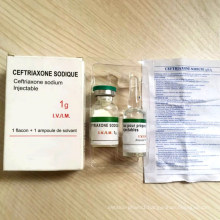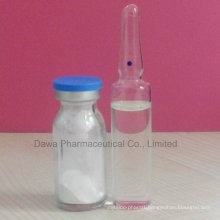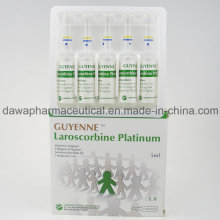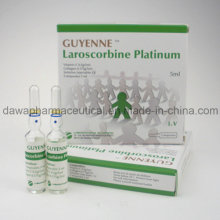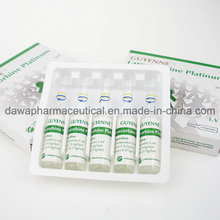Ready Stock Folic Acid Vitamin B9&Vitamin Bc&Vitamin M
Basic Info
Model No.: HEA451856M
Product Description
Model NO.: HEA451856M Usage Mode: For oral administration Shape: Oral Liquid Pharmaceutical Technology: Chemical Synthesis Brand&Origin: Guyenne, France Packing: 10AMPS/Tray/Box Sample: Acceptable Quality Standard: GMP/Who GMP/Euro GMP Trademark: guyenne Specification: GMP/WHO GMP/EURO GMP HS Code: 3004909090 Application: Internal Medicine State: Liquid Type: Biological Products Name: Folic Acid Specifications: 10mg/Ml MOQ: 1 Box Delivery Time: 7 Days Shelf Life: 36 Months Transport Package: 10AMPS/Tray/Box Origin: France Names
Identifiers
PropertiesPharmacology
Folic acid or folate is a B vitamin. It is also referred to as vitamin M,vitamin B9, vitamin Bc,(or folacin), pteroyl-L-glutamic acid, and pteroyl-L-glutamate.
Food supplement manufacturers often use the term folate for something different from "pure" folic acid: in chemistry, folate refers to the deprotonated ion, and folic acid to the neutral molecule-which both coexist in water. The International Union of Pure and Applied Chemistry and the International Union of Biochemistry and Molecular Biology state that folate and folic acid are the preferred synonyms for pteroylglutamate and pteroylglutamic acid, respectively.
Vitamin B9 is essential for numerous bodily functions. Humans cannot synthesize folates de novo; therefore, folic acid has to be supplied through the diet to meet their daily requirements. The human body needs folate to synthesize DNA, repair DNA, and methylate DNA as well as to act as a cofactor in certain biological reactions. It is especially important in aiding rapid cell division and growth, such as in infancy and pregnancy. Children and adults both require folate to produce healthy red blood cells and prevent anemia.
A lack of dietary folates can lead to folate deficiency. A complete lack of dietary folate takes months before deficiency develops as normal individuals have about 500-20,000 micrograms ( µg) of folate in body stores. This deficiency can result in many health problems, the most notable one being neural tube defects in developing embryos-a relatively rare birth defect affecting 300,000 (0.2%) births globally each year and 3,000 pregnancies in the United States each year. Common symptoms of folate deficiency include diarrhea, macrocytic anemia with weakness or shortness of breath, nerve damage with weakness and limb numbness (peripheral neuropathy), pregnancy complications, mental confusion, forgetfulness or other cognitive deficits, mental depression, sore or swollen tongue, peptic or mouth ulcers, headaches, heart palpitations, irritability, and behavioral disorders. Low levels of folate can also lead to homocysteine accumulation. Low levels of folate have been associated with specific cancers. However, it is not clear whether consuming recommended (or higher) amounts of folic acid-from foods or in supplements-can lower cancer risk in some people.
Identifiers
PropertiesPharmacology
| Folic acid | |
| IUPAC name (2S)-2-[[4-[(2-Amino-4-oxo-1H-pteridine6-yl)methylamino]benzoyl]amino]pentanedioic acid | |
| Other names N-(4-{[(2-amino-4-oxo-1,4-dihydropteridin-6-yl)methyl]amino}benzoyl)-L-Glutamic Acid; pteroyl-L-Glutamic Acid; Vitamin B9; Vitamin Bc; Vitamin M; Folacin | |
| CAS Number | 59-30-3 |
| ChEBI | CHEBI:27470 |
| ChEMBL | ChEMBL1622 |
| ChemSpider | 5815 |
| DrugBank | DB00158 |
| IUPHAR/BPS | 4563 |
| Jmol interactive 3D | Image |
| KEGG | C00504 |
| PubChem | 6037 |
| RTECS number | LP5425000 |
| UNII | 935E97BOY8 |
| Chemical formula | C19H19N7O6 |
| Molar mass | 441.40 g·mol?1 |
| Appearance | yellow-orange crystalline powder |
| Melting point | 250 °C (482 °F; 523 K) (decomposition) |
| Solubility in water | 1.6 mg/L (25 °C) |
| log P | -2.5 |
| Acidity (pKa) | 1st: 4.65, 2nd: 6.75, 3rd: 9.00 |
| ATC code | B03BB01 |
Folic acid or folate is a B vitamin. It is also referred to as vitamin M,vitamin B9, vitamin Bc,(or folacin), pteroyl-L-glutamic acid, and pteroyl-L-glutamate.
Food supplement manufacturers often use the term folate for something different from "pure" folic acid: in chemistry, folate refers to the deprotonated ion, and folic acid to the neutral molecule-which both coexist in water. The International Union of Pure and Applied Chemistry and the International Union of Biochemistry and Molecular Biology state that folate and folic acid are the preferred synonyms for pteroylglutamate and pteroylglutamic acid, respectively.
Vitamin B9 is essential for numerous bodily functions. Humans cannot synthesize folates de novo; therefore, folic acid has to be supplied through the diet to meet their daily requirements. The human body needs folate to synthesize DNA, repair DNA, and methylate DNA as well as to act as a cofactor in certain biological reactions. It is especially important in aiding rapid cell division and growth, such as in infancy and pregnancy. Children and adults both require folate to produce healthy red blood cells and prevent anemia.
A lack of dietary folates can lead to folate deficiency. A complete lack of dietary folate takes months before deficiency develops as normal individuals have about 500-20,000 micrograms ( µg) of folate in body stores. This deficiency can result in many health problems, the most notable one being neural tube defects in developing embryos-a relatively rare birth defect affecting 300,000 (0.2%) births globally each year and 3,000 pregnancies in the United States each year. Common symptoms of folate deficiency include diarrhea, macrocytic anemia with weakness or shortness of breath, nerve damage with weakness and limb numbness (peripheral neuropathy), pregnancy complications, mental confusion, forgetfulness or other cognitive deficits, mental depression, sore or swollen tongue, peptic or mouth ulcers, headaches, heart palpitations, irritability, and behavioral disorders. Low levels of folate can also lead to homocysteine accumulation. Low levels of folate have been associated with specific cancers. However, it is not clear whether consuming recommended (or higher) amounts of folic acid-from foods or in supplements-can lower cancer risk in some people.
1 Health effects
National Institutes of Health (US) Nutritional Requirements (µg per day)AgeInfants (RDI)Infants (UL)Adults (RDI)Adults (UL)Pregnant women (RDI)Pregnant women (UL)Lactating women (RDI)Lactating women (UL)
Product Categories : Anti-Age Products Other Products
Hot Products High Quality 200mg Amiodarone Hydrochloride TabletsLarge Stock Whiten Skin Monobenzone CreamGeneral Medicine Omeprazole 20mg Injection for Gastrohelcosis and Stomach AcidGeneral Medicine Ceftriaxone Sodium InjectionPharmaceutical Chlornitromycin CAS 56-75-7 Chloroamphenicol for Veterinary Use (Oap-014)Ready Stock Skin Whitening Anti-Aging Vitamin C InjectionCAS 57-85-2 Injectable Steroid Compound Testosterone PropionateHigh Quality Usnic Acid with High PurityMuscle Builder Weight Loss Homebrew Steroids Testosterone SustanonFDA Approved Curative Antimalarial ArtemisininMedicine Treating Brain Injury Citicoline Sodium InjectionProtease Alpha Chymolase for Inflammatory EdemaGeneral Medicine Medroxyprogesterone Acetate InjectionAmikacin Injection General Medicine DrugsSkin Whitening Gsh Personal Care Glutathione InjectionBody Slimming Fitness Lose Weight Weight Loss L-Carnitine Injection2.0g/5ml |

